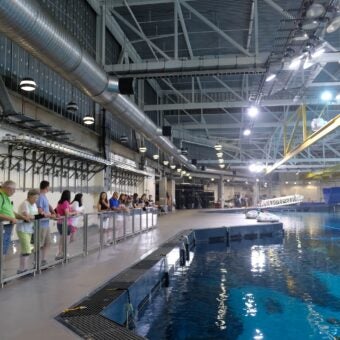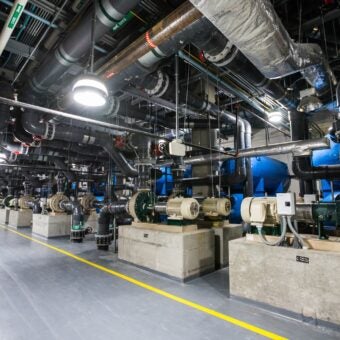-
Size
Polyps can be as small as 1mm, colonies together can grow much larger -
Diet
Algae, zooplankton -
Range
Tropical waters around the world -
Habitat
Shallow waters that allow sunlight for growth
Physical Characteristics
- All species of soft coral have eight tentacles which provide defense, capture food and clean debris. They are part of the sub-class Octocorallia.
- Nematocysts in tentacles release an often-fatal toxin into prey or threats.
- Gorgonians have a protein-based skeleton composed of gorgonin or tightly clustered calcium carbonate spicules. Non-gorgonians have calcium carbonate spicules imbedded throughout their tissue
- In some cases, polyps will specialize based on their physical position in the colony. For example, central polyps form a supporting structure.
- Some soft corals do not have zooxanthellae in tissue. However, all species that we currently have represented at the Aquarium contain zooxanthellae.
Animal Fun Fact
Corals are not adapted to the current, increased rate of ocean acidification and face long-term detrimental effects.
Diet / Feeding
- Stomach has one opening – the mouth. It is surrounded by tentacles that capture food. Food enters mouth and leaves mouth once it has been digested.
- Feeds predominantly at night.
- Polyp receives nutrients by:
- Filtering food from water with its tentacles, capturing food by using stinging nematocysts.
- Mutualistic zooxanthellae (single-celled algae) receive water and carbon dioxide from the polyp, photosynthesizing the latter into oxygen, carbohydrates and lipids.
Range / Habitat
- Tropical corals generally require temperatures ranging from 73.4ᵒ to 84.2ᵒ Fahrenheit (23-29ᵒ C).
- No deeper than approximately 230 feet (70 m) for sunlight, which is required for photosynthesis to occur.
- Clear water with little sedimentation to allow for feeding and sunlight penetration.
- Appear in reefs, though are not usually involved in reef-building. (An exception: Heliopora is an octocoral and a reefbuilder that builds a massive skeleton.)
Reproduction & Growth
Asexual reproduction
- Budding: new polyps develop once the parent polyp grows to a certain size and then divides.
- Fragmentation: a new colony forms from a broken-off portion of an established colony. The success of this genetically identical colony depends on the growth conditions to which it is exposed.
- Occurs frequently in the wild, especially with branching coral species as they break apart with passing storms and heavy wave action.
Sexual reproduction
- Broadcast spawning:
- Occurs in about 75% of hard coral species.
- Corals can be either gonochoric (separate sexes) or hermaphrodites (having both male and female sex organs). Typically corals that are hermaphrodites cannot self-fertilize, so gametes of two distinct genotypes need to be present for fertilization to be successful.
- Female and male gametes (egg and sperm) are released into the water column in great numbers and cover a vast geographic area.
- Buoyant, they float towards the surface. In species that are hermaphrodites, the egg/sperm bundles break apart in the wave action.
- Egg and sperm will meet and form larva (planula).
- Depending on the coral species, planulae either start swimming immediately or drift as they need several days for development. Once the coral planulae are swimming they use various settlement cues to find a suitable location to call their home.
- Biotic (living) cues include coralline algae, bacterial films
- Abiotic (non-living) cues include light levels
- Timing is crucial. The synchronized event is believed to be the response to environmental cues (i.e. temperature, temperature change, day length, lunar cues).
- Despite the distance, a spawning event for any given species of coral will occur at one time.
- It is possible for a species to spawn for one or a few nights each year.
- Brooding:
- Occurs in about 25% of hard coral species.
- Only male gametes are released and are not buoyant, greatly reducing the distance it travels.
- If the waves or current bring the male gamete to the female polyp, it is taken in by the female for fertilization.
- Once developed, the larva (planula) is released through the female polyp’s mouth and able to find a hard substrate (surface) to attach itself to.
Conservation Status
- Varies on a per-species basis, but coral reefs in general face threats from pollution, climate change and other factors.
- While oceans are absorbing and bearing a large brunt and absorbing excess carbon dioxide in the atmosphere (as much as 30% of the total), the result is acidification at an accelerated rate.
- Corals are not adapted to the current, increased rate of ocean acidification and face long-term detrimental effects.
Additional Information
- There are also deep-water/cold-water corals:
- There are stony and black/horny varieties in deep water ranging to 6561 feet (2000 m).
- Waters as cold as 39ᵒ Fahrenheit (4ᵒ C).
- No zooxanthellae.





